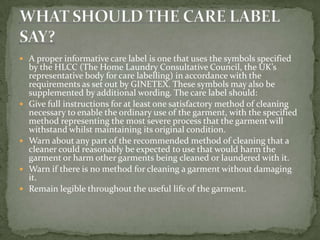care labelling
- 2. ? In the UK Care Labelling is a voluntary system. However, current Trading Standards practice suggests that when a care label has been put into a garment (or any textile item) then that label becomes part of the description of the article in respect of the "Sale of Goods Act – Fitness for Purpose" and is therefore legally binding. Consumers can encourage good practice by buying only garments that have been care labelled properly. No care label – Do Not Buy.
- 3. ? A care label gives the recommended care instructions. The label must be attached so that it will not become separated from the product, and it must remain legible during the useful life of the product. You should be able to see the care label or find it easily. ? When a garment has two or more parts that are sold as a unit, only one care label is required. However if each piece is designated to be sold separately or if each piece requires different care procedures, the each part of the article must have its own label. ‘If you have a two-piece, always take both pieces to the cleaner.
- 4. ? A proper informative care label is one that uses the symbols specified by the HLCC (The Home Laundry Consultative Council, the UK’s representative body for care labelling) in accordance with the requirements as set out by GINETEX. These symbols may also be supplemented by additional wording. The care label should: ? Give full instructions for at least one satisfactory method of cleaning necessary to enable the ordinary use of the garment, with the specified method representing the most severe process that the garment will withstand whilst maintaining its original condition. ? Warn about any part of the recommended method of cleaning that a cleaner could reasonably be expected to use that would harm the garment or harm other garments being cleaned or laundered with it. ? Warn if there is no method for cleaning a garment without damaging it. ? Remain legible throughout the useful life of the garment.
- 5. ? If a manufacturer decides to put in a Care Label it should be attached at the time of purchase so that the consumer can take care instructions into consideration before making a purchase. Occasionally, you may wish to remove the care label, but this may entail some risk as full information or warning regarding proper care will no longer be available to either yourself or the drycleaner/launderer.
- 7. ? Very hot.Maximum washSpin or wring. ? Whitecottonandlinenarticles. Without special finishes ? Very Hot.Minimum washDrip-dry. ? Cotton articles withspecial finishes capableof being boiled but requiring drip-drying
- 8. ? Hot.Maximumwash. Spin or wring. ? ? Cotton, linen or viscose ? articles without special finishes where colours are fast at 60°C ? ? Hot. Medium wash. ? Cold rinse, short spin or drip-dry. ? White nylon, white ? polyester/cotton mixtures.
- 9. ? Hand-hot. Medium ? wash. Cold rinse, ? short spin or drip-dry. ? ? Coloured nylon, polyester, cotton and viscose acrylic/cotton mixtures.
- 10. Warm. Maximum Cotton, linen or viscose wash. Spin or articles where colours are wring. fast at 40°C but not at 60°C. Acrylics, acetate and Warm. Minimum triacetate, including wash. Spin. Do not mixtures with wool, hand wring. polyester/wool blends. Warm. Minimum Wool, including blankets and wash. Spin. Do not wool mixtures with cotton or hand wring viscose, silk.
- 11. Cool. Minimum Silk and printed acetate wash. Cold rinse, fabrics with colours not fast short spin. Do not at 40°C. wring.
- 12. Articles which must not be machine-washed HAND WASH If drycleanable steaming or Do not wash prespotting may cause problems of dye bleeding.
- 13. ? HOT(200°C)Cotton, Linen, Viscose. ? WARM (150°C)Wool, Polyestermixtures. ? COOL (110° C)Acrylic, Nylon, Triacetate, Polyester.
- 14. ? Normal textiles drycleanable in all solvents. Normally used for drycleaning ? ? Normal textiles drycleanable in perchloroethylene, white spirit, Solvent R 113, Solvent 11.
- 15. ? Textiles sensitive to drycleaning which may be cleaned with the same solvents shown for P but with a strict limitation. Examples: acrylic, velvet, unlimted woollens. ? Normal textiles drycleanable in white spirit. HCS and Solvent R 113.
- 16. ? Textiles sensitive to drycleaning which may be cleaned with the same solvents shown for F but with a strict limitation. Examples glitter fabric. ? Do not dryclean, be careful with spot removal. Example, pvc coating: rubberised fabrics
- 17. ? Chlorine bleaching isallowed ? Do not use chlorine bleach
- 18. ? Tumble dry ? Do not tumble




















